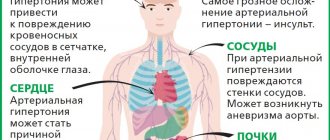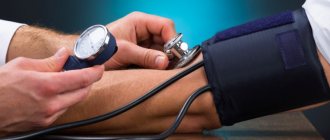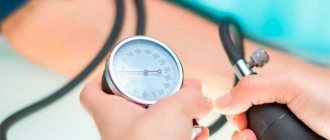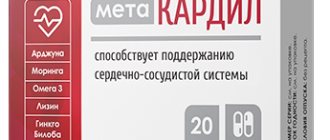What are the benefits of physical therapy for hypertension?
Physical activity is the main part of a drug-free program for overcoming hypertension. Loads increase the intensity of muscle contractions. This reduces the lack of microvibration, and toxins and waste products are more actively removed from the body. As a result, the pressure in the kidneys decreases, immunity increases, and atherosclerotic plaques, which adversely affect the state of the body, cease to form on the walls of blood vessels. All these conditions create conditions for lowering blood pressure.
Important! Before starting any kind of exercise, you should consult your doctor to rule out contraindications.
Physical therapy to lower blood pressure using the Shishonin method
Dr. Shishonin’s exercises for hypertension will help you get rid of high blood pressure, headaches, migraines, sleep problems and other unpleasant manifestations of the disease through the effect on the cervical spine.
Here are the following exercises to reduce blood pressure:
- Metronome. Sit on a chair, tilt your head left and right, holding each side for 30 seconds.
- Spring. Tilt your head as far down as possible so that your chin touches your chest. Freeze for 30 seconds. Then stretch your neck forward and freeze again. Move your head to the side, and again do not move for 30 seconds. Go back to the beginning. Perform 4-5 turns on each side.
- Fakir. Place your palms behind your neck. Bend your elbows as tight as you can. Turn your head from left to right, freezing in each direction for half a minute.
- Heron. IP - sitting. Place your palms on your knees. Stretch your chin up while looking at the ceiling. At the same time, move your arms back. Hold for 5 seconds. Bring your chin down and your arms forward. Rest and do it all again.
- Goose. IP - standing. Position your head so that your chin is parallel to the floor. Pull your neck forward until you feel pain. Stop for 2-3 seconds and return to the starting position. Rest and repeat everything from the beginning again.
These 5 exercises for hypertension will normalize blood pressure, relieve headaches, and help increase strength and energy. Dr. Shishonin recommends performing neck exercises for hypertension efficiently and slowly, so as not to provoke an exacerbation of hypertension.
Video: Dr. Shishonin's exercises
Dr. Strelnikova’s complex against hypertension
Doctor Strelnikova, whose methods have long been used by modern cardiologists, also recommended lowering blood pressure with exercises. To achieve tangible results, you need to do gymnastics regularly every day. The course is 2 months.
The basis of the technique is correct breathing.
- Palms. Stand up, fold your arms so that your palms are at shoulder level. Turn your palms forward. Take a powerful breath through your nose, while clench your fists. Exhale and loosen your hands again.
- Shoulder straps. Bend your arms so that your fists are at shoulder level. Inhale loudly, lowering and straightening your arms. Exhale, and enter the I.P.
- Horse. IP - any comfortable position in which the back remains level. Relax, take 4 deep breaths through your nose without interruption. Hold your breath for a couple of seconds and slowly return to the starting position.
- Pump. Place the legs at shoulder level. Bend over so that your back is slightly rounded. Inhale the air forcefully, straighten up, and only then exhale.
- The cat exercise is performed while standing. Bend your elbows and place your palms behind you at lower back level. Take a deep breath and turn to one side. Turn back and exhale calmly. Repeat everything from the beginning, but for the other side. At the same time, breathe noisily and deeply.
- Pendulum. Inhale and bend forward. As you exhale, straighten up and hug yourself with your arms. Turn your neck first in one direction and then in the other. Inhale during the turn, exhale during the starting position.
- Ears. Tilt your head towards one of your shoulders. While bending over, take a deep, powerful breath. Exhale while straightening your neck.
- Pendulum head. Inhale, while tilting your head forward, and as you exhale, return to the i.p.
Interesting! When performing exercises to normalize pressure according to the Strelnikova system, you should pay special attention to proper breathing. Inhalation is done through the nose and exhalation through the mouth. All actions should be performed about 6-8 times. With adaptation to loads, you can increase the number of repetitions. If your health deteriorates, it is better to temporarily interrupt exercise therapy.
Material on the topic: What exercises can you do after a heart attack.
Light breathing exercises
Breathing exercises to lower blood pressure help almost all hypertensive patients; it can saturate the body with oxygen, strengthens the heart and vascular system, and can speed up metabolic processes in the body.
If your blood pressure starts to rise, doctors recommend starting with simple activities:
Take a big breath and hold your breath for 15 seconds.- Exhale slowly.
- After 30 seconds, repeat, but hold your breath 5 seconds longer each time.
- Do about 10 repetitions.
Such exercises should be combined with exercises to normalize the condition and reduce blood pressure. In a simplified version of gymnastics, you need to take a lot of breaths. The start of therapy is 10 minutes, 80 breaths are taken. After a few days, you need to increase the number of breaths and time. After 60 days there should be about 5000 breaths per hour. This complex should be carried out 2 times a day.
Exercises according to Strelnikova
Strelnikova’s course helped many hypertensive patients to steadily reduce and normalize blood pressure. All types must be done from a standing position and performed in turn. Repeat each exercise about 6-8 times, but over time the number should increase.
During all movements, breathing should be sharp, and also include many short inhalations and long exhalations.
The full course for hypertension is as follows:
Palms. You need to spread your arms to the sides, bend them so that they are vertical to the floor, and turn your palms away from you. Clench your fists while taking strong but small breaths. Take one big exhale and repeat the exercise up to 6 times. A pause is made for 10 seconds and everything is repeated up to 8 times.- Shoulder straps. Bend your arms at the waist, clench your palms into fists. Taking a strong breath, lower your arms down and unclench your palms with your fingers spread as far apart as possible. Do 8 repetitions without rest, then pause for 10 seconds. Number of approaches up to 8 times.
- Pump. Relax your arms and shoulders, lower them to the floor as much as possible. Bend slowly down and inhale with a sound, and then exhale and straighten up. Repeat 12 times, rest for 5 seconds.
- Hug your shoulders. Bend your arms in front of you, make a lock, your right palm should be directed towards the floor and located under your left elbow. While inhaling quickly, hug yourself, exhale calmly and take the starting position. Repeat 8 times for 9 approaches with an interval of 10 seconds.
- Turn your head. You need to turn your head to the sides, while sharply inhaling air. You can exhale arbitrarily with your mouth open. The exercise involves 8 repetitions with 12 approaches for each side with an interval of 4 seconds.
- Pendulum. Take the bottom position from the “Pump” exercise and do the “Hug your shoulders”. Repeat 8 times for 8 approaches, at intervals of 10 seconds.
By doing the described exercises for hypertension every day, you can ensure that high blood pressure levels decrease. Results appear within a week of the complex.
Exercises according to Bubnovsky
This type of exercise is suitable for lowering blood pressure at home. Starting position - on all fours, resting on your palms and knees. You need to bend your back.
The rest of the set of exercises is carried out from the described position:
- You need to sit on your left leg, bending it, and pull your right leg back. The left leg is extended as far forward as possible so that the body lowers closer to the floor. During movements, you need to include your right hand on your left leg, then vice versa. Inhalations are carried out at the last points. 20 movements are performed at a time.
- It is necessary to stretch your back, but the starting position should be on your elbows, not your palms. As you exhale, lower your body to the floor, while inhaling, straighten your arms, trying to stand on your heels. Exercise reduces blood pressure and strengthens the muscles of the back and lower back. The number of repetitions should be 6 times.
You cannot rely solely on the described complex for hypertension. In severe cases, you cannot do without pills, so the doctor’s advice should not be neglected.
- Therapeutic gymnastics by Evdokimenko for hip joints: video exercises
Exercises according to Buteyko
This complex is also based on breathing exercises; the essence is to use 3 basic exercises, which should be alternated between dynamic and calm ones:
- Hold the breath. The essence of the exercise is an artificial lack of air. The breath is held for 10 seconds, after which small breaths are taken for 1-2 minutes.
- Hold your breath while walking. It is necessary to hold your nose with your fingers and not breathe for as long as possible. After breathing normalizes, you need to repeat the exercise about 3 times.
- Shallow breathing. You need to sit down and relax your diaphragm. Breathing is carried out very easily through the nose, in a normal rhythm, for 3 minutes. Deep breaths are prohibited during the exercise.
This complex makes it possible to relieve high blood pressure within a week.
Qigong exercise
This method is very old, it is a Tibetan method of reducing blood pressure, which can be used for different types and degrees of hypertension. Exercises are best suited for primary hypertension, which is an independent pathology, without additional complications. During the exercise, blood circulation improves due to the renewal of oxygen and carbon dioxide. If you use the complex for 6 months, then stable pressure appears within the normal range or close to that value. Most often, patients report complete improvement.
To perform the exercises correctly, you need to know all the rules:
- When breathing, the chest should not move; diaphragmatic breathing is used accordingly.
- When you inhale, the abdominal cavity inflates, and when you exhale, it retracts.
- The spine and head should be in a straight line.
- All exercises should be performed at rest.
- The complex is selected based on the condition of the hypertensive patient, taking into account the physical level of training.
- The time and number of exercises should be gradually increased.
- To permanently reduce and normalize blood pressure, you need to carry out exercises on an ongoing basis, persistently.
The Qigong method includes many exercises, but there is no point in using the full complex, because not all types help with hypertension. If you suffer from high blood pressure, you should use only some common types, which are divided into basic and additional.
Basic exercises to reduce blood pressure include:
- Relaxation. Allows you to find harmony of the heart. The entire body must be visually divided into 3 parts. The first includes the side part of the head, neck and arms, the second includes the front part of the body from the lower part of the face to the legs, and the last includes the bottom of the back of the head to the heels. Take a comfortable sitting or standing position, you need to concentrate on all areas and say “relaxed” to yourself. When complete relaxation begins, you will need to concentrate on the groin area and gradually come out of relaxation. Carry out up to 4 similar exercises.
- Pillar. Place your feet shoulder-width apart and place your hands on your belt. Just breathe for about 3 minutes, and then do the first exercise.
- Hug the ball. You need to lie on a flat surface and bend your legs, and hug an imaginary circle with your arms. Try to relax as much as possible.
- The work of thought. After the previous exercise, you need to work on the main idea. If you have high blood pressure, it is recommended to imagine a bath and the sounds of water. Breathe naturally.
A full set of basic exercises takes about 10 minutes, but over time you need to increase the period. The described methods should be used 2-5 times a day. Conditions should be comfortable.
You also need to use additional exercises, which can be done at any convenient time. To effectively reduce pressure you need:
- Point massage the sole.
- Perform a lower back massage.
Constantly following the described course with concentration on exhalations should normalize the functioning of the nervous system, due to which the pressure decreases.
- A set of exercises for coxarthrosis of the hip joint: treatment at home
For hypertension, you can use a complex of 6 words. The entire course will take about an hour and for lasting results it is better to do it 2 times a day. You need to stand, join your arms along your body and concentrate on breathing (inhalation).
While exhaling, make sounds:
- Su.
- Heh.
- Hu.
- Si.
- Chuy.
- Si.
The respiratory complex is useful not only for hypertension, but also for the whole body. The described remedies can stabilize blood pressure, improve well-being and general condition, and also have a positive effect on the functioning of the heart.
Exercise therapy complex for normalizing blood pressure using the Buteyko method
Exercise therapy for hypertension, which was proposed by the doctor and scientist Konstantin Buteyko, has an extremely beneficial effect on the body: it saturates the organs with oxygen, strengthens blood vessels, and improves blood flow.
Important! According to Buteyko’s observation, the complex will help the patient completely get rid of the disease. Physical exercise normalizes the relationship between the volume of carbon dioxide and oxygen in the body.
Main rules of implementation:
- Gymnastics is performed while sitting, the body is relaxed, and the gaze is directed upward.
- Inhale through your nose, exhale through your mouth, breathe evenly, do not use the full volume of your chest.
- If you feel short of breath, take a deep breath.
If the execution goes correctly, a feeling of spreading warmth appears throughout the body, which intensifies with each new activity.
Exercises for high blood pressure are performed on an empty stomach. You need to inhale as silently as possible through your nose:
- Breathing is performed from the upper part of the lungs. Inhale and exhale for 5 seconds, then take a break for 5 seconds (do not breathe). Complete 10 repetitions in total.
- Breathe with your stomach and chest. At the same time, you can visually observe the movements of the chest and abdomen. Just 8 seconds to perform, and 5 seconds to rest (hold your breath). Perform 10 repetitions.
- Hold your breath for 7-10 seconds and massage your nose.
- Breathe 20 times on each side of your nose.
- Take in the air, pull in your stomach for 8 seconds, exhale, returning to IP for 8 seconds. Pause for 5 seconds and repeat everything from the very beginning 10 times.
- Do 12 powerful inhalations and exhalations in a minute. As you exhale for the last time, hold for 5 seconds. Return to i.p.
Execution Features
At the beginning of the therapeutic course, you should perform simple physical training techniques without excessive stress on the muscular system, which are complemented by breathing and relaxation techniques.
In addition to special physical training, hypertensive patients are recommended to take walks and visit the swimming pool.
At the first stage of hypertension, when well-being improves and tolerance to stress increases, the intensity of exercise gradually increases. Light running and gymnastics are added to the complex, which involve all major muscle groups. A month after the start of exercise therapy, it is performed in full, and the number of repetitions is increased to 8–9 times.
Exercises for stage 2 hypertension become more complicated only after a three-week course. Patients should be careful about heavy loads and avoid running. The number of repetitions increases up to 8 times. And only after a month, on the recommendation of your doctor, you can start running.
No ads 1
In the second and third stages of the pathology, therapeutic exercises can be carried out in a hospital, even when the patient is recommended to rest in bed. Simple exercises are prescribed that involve the muscles of the lower and upper extremities. To train vascular reactions and balance, they resort to the technique of alternately changing the position of the head and neck in space. Breathing techniques can also be performed in a supine position, but to improve pulmonary circulation it is necessary to elevate the upper shoulder girdle.
If your general condition worsens, your heart rate increases to more than 100 beats/min, and does not stabilize after 10 minutes of rest, you should avoid intense exercise and switch to breathing exercises.
Classes using the method of Dr. Bubnovsky
The famous doctor Sergei Bubnovsky developed a special technique for lowering blood pressure. It consists of several simple and accessible blocks that any patient can handle.
We present to your attention the treatment of hypertension with exercises from the master + video by S. Bubnovsky, in which all the intricacies of performing physical activity are clearly explained.
- Start by walking. Walk while taking deep, measured breaths. Every 5th step, change the type of walking: on your toes, cross step, side step, on your heels. Move to the outside/inside of the foot.
- Bend your body forward, lower your hands to the level of your heels, and straighten up. Repeat the movement 3-4 times. Do not lower your head too low.
- Sit down, focus on your hands. Do the “bicycle” exercise with your legs. It is important to raise the legs to a comfortable height; for 1 breath there are 4 “bicycle” movements. Exhale - legs lower. Only 6 approaches.
- Sit on a chair, lower your arms down, and move your shoulders in a circle. Do 5 repetitions.
- Sit on a chair with your legs as wide apart as possible. While taking a deep breath, get up from the chair, and when you exit, sit down again. Keep your balance.
- Stand with your feet shoulder-width apart. Inhale, while turning to the right 3 times, leaving your legs in place and spreading your arms to the sides. Exhale and stand straight again. Repeat the same manipulation in the other direction.
If you follow all the tips correctly, you can quickly bring your blood pressure back to normal and keep it at the level. What sports activities do you prefer? Let readers know about your experience in the comments.
FAQ
Is it possible to play sports, run or ride a bike if you have arthrosis?
With arthrosis, there are many restrictions on playing sports. Any type of physical activity is strictly contraindicated, especially team sports and other disciplines with a high probability of joint injury. Light running, walking, and fitness with limited stress on sore joints are allowed. An exercise bike is useful.
Is it possible to combine exercise therapy with other methods of treating arthrosis?
It is not only possible, but also necessary to support joints with drug treatment and physiotherapeutic procedures.
Is it possible to combine different exercise therapy techniques?
It is possible and necessary to combine different techniques, especially gym classes and swimming. In any case, the final decision on the exercise therapy technique remains with the attending physician.
Read about other methods of treating arthrosis in this article.
Literature:
- Ulashchik, V. S. Therapeutic physical culture // Physiotherapy: Universal medical encyclopedia. - Mn.: Book House, 2008. - P. 308-315. - 640 p.
- Therapeutic physical culture / Ed. S. N. Popova. Physical education and sport, 1988, 271 p.
- Dubrovsky V.I. Therapeutic physical culture: textbook. for students universities - M.: VLADOS, 1998-608s.
- Epifanov, V. A. Therapeutic physical culture. - M.: Medicine, 1987. - 528 p.
Themes
Arthrosis, Joints, Pain, Treatment without surgery Date of publication: 05/25/2021 Date of update: 08/25/2021
Reader rating
Rating: 5 / 5 (1)











